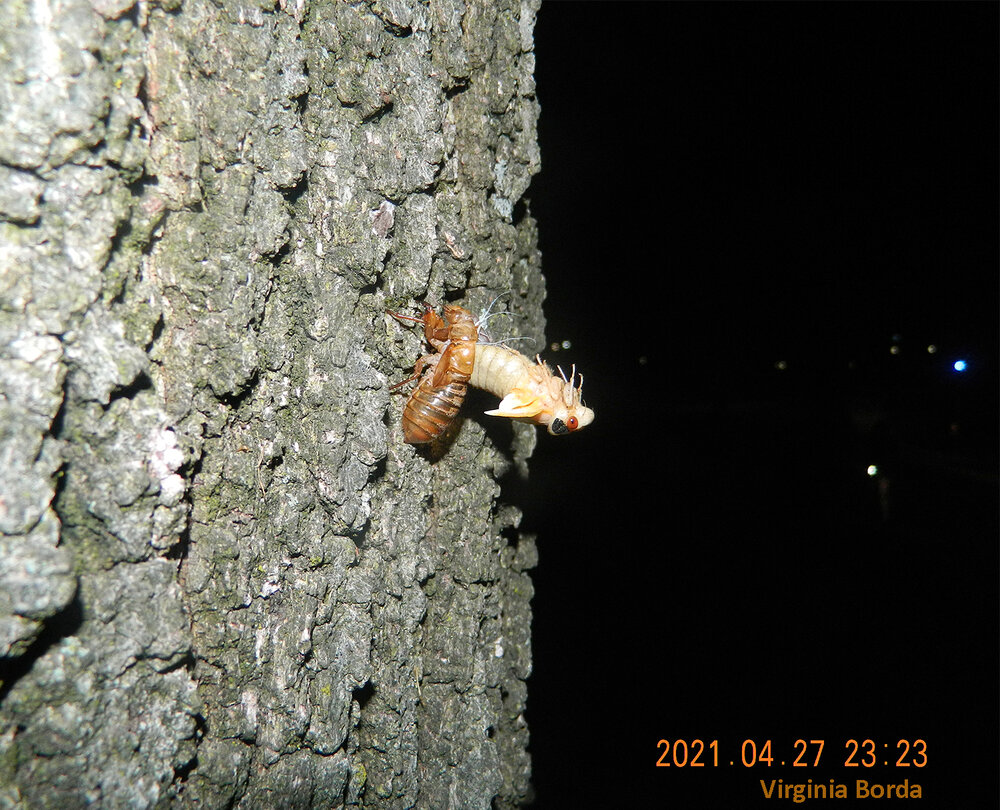Periodical cicadas come to the University of Maryland – will there be a reward for finding blue-eyed cicadas? Magicicada spp.

Just what is the reward for finding a blue eyed cicada?

A beautiful Brood X cicada sheds its exoskeleton on an ancient oak tree at the University of Maryland, College Park. Photo credit: Virginia Borda
Recent episodes of Bug of the Week explored elements of cicada biology and several frequently asked questions about the soon-to-erupt volcano of Brood X periodical cicadas. We dispelled the notion that cicadas were locusts, put to rest the idea that they hibernated for 17 years underground, explained what was up with all those holes in the ground, and provided an educated guess as to when they might be seen in our region. Save for a lone outlier that showed up early just outside of Towson on April 19th and another that emerged in Rockville a few days later, adult cicadas remained scarce not only in our area, but around the nation. Last week all of this changed with scores of adult cicadas coming out of the ground in Tennessee and North Carolina. Closer to home several eagle-eyed students witnessed emerging cicadas ascending one of the stately ancient oak trees on the College Park campus of the University of Maryland as night fell on April 27th. With air temperatures in the 70s and 80s this week, rain expected, and soil temperatures bouncing around the mid-60s, conditions seem right for the massive jailbreak to begin in some locations in our region. For several other broods Bug of the Week has visited, a warm day with an afternoon thunderstorm seems to create favorable conditions to trigger an emergence. Perhaps the higher relative humidity that follows a rain facilitates the Houdini-like escape of the cicada from its nymphal skin and reduces the chance of an early death.
On the night of April 27th, 2021, students in an ecology course recorded periodical cicadas emerging from the soil and scaling an ancient oak tree on the campus of the University of Maryland, College Park. Due to its rich tree canopy and long history of Brood X cicada appearances, tens of thousands of periodical cicadas will emerge on campus over the next several weeks. Video credit: Colette Lord

Orange, white, and vermillion are other eye color variants seen in periodical cicadas.
Over the past weeks, several attendees viewing virtual presentations about cicadas wanted to hear the legend of blue-eyed cicadas. Are there blue-eyed cicadas and, more importantly, is there a reward if you find one? The answers are yes and yes. Eye color in insects is a somewhat complicated phenomenon and dependent on which species of insect you are talking about. One of the most well-known examples of eye coloration comes from your old freshman biology buddy, the fruit fly. Noble Prize Winner T. H. Morgan used his discovery of a white eyed mutant of the normally red eyed fruit fly, Drosophila melanogaster, to describe patterns of inheritance and create the first genetic maps. While beneath the earth as nymphs, periodical cicadas have white eyes devoid of pigments. During the year of emergence, eye color changes to a deep vermillion, a color similar in shade to that seen in many species of flies. The red color of fly eyes is created by a group of ommochrome and pteridine pigments known as screening pigments. These pigments filter white light and enable red wavelengths to assist the normal function of rhodopsin, a photosensitive pigment found in the eye of the fly. Mutations affecting the formation of pigments alter eye color in these and other flies. Is the same true for cicadas? While failing to find a specific reference on the physiological mechanism governing eye color in cicadas, observing variation in cicada eye color is never a problem, if you observe enough cicadas. I see variation in color within every brood. The most common color is a deep red hue, but sometimes shades of orange, white, or beautiful pale blue are seen.
And what about the reward for finding a blue eyed cicada? Well, the reward is simply that you found one. As cicadas emerge, please take the time to look many in the eye and claim your reward. Happy hunting!
Acknowledgements
Bug of the Week thanks Colette, Virginia and Trinadee for their brilliant observations of periodical cicadas on our campus this week. Special thanks to Colette and Virginia for sharing their images and videos and to Dr. Dan Gruner for putting his ecology students on cicada reconnaissance missions. The interesting article “Colour in the eyes of insects” by D.G. Stavenga was consulted for this episode.
This post appeared first on Bug of the Week